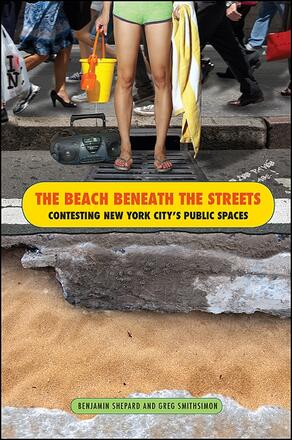
The Beach Beneath the Streets
Contesting New York City's Public Spaces
Alternative formats available from:
Examines New York City as a paradigmatic example of the tensions between privatization and public uses of space in the contemporary U.S.
Description
Focusing on the liberating promise of public space, The Beach Beneath the Streets examines the activist struggles of communities in New York City—queer youth of color, gardeners, cyclists, and anti-gentrification activists—as they transform streets, piers, and vacant lots into everyday sites for autonomy, imagination, identity formation, creativity, problem solving, and even democratic renewal. Through ethnographic accounts of contests over New York City's public spaces that highlight the tension between resistance and repression, Shepard and Smithsimon identify how changes in the control of public spaces—parks, street corners, and plazas—have reliably foreshadowed elites' shifting designs on the city at large. With an innovative taxonomy of public space, the authors frame the ways spaces as diverse as gated enclaves, luxury shopping malls, collapsing piers and street protests can be understood in relation to one another. Synthesizing the fifty-year history of New York's neoliberal transformation and the social movements which have opposed the process, The Beach Beneath the Streets captures the dynamics at work in the ongoing shaping of urban spaces into places of repression, expression, control, and creativity.
Benjamin Shepard is Assistant Professor of Human Services at New York City College of Technology, CUNY. He is the author or editor of several books, including White Nights and Ascending Shadows: An Oral History of the San Francisco AIDS Empidemic, and From ACT UP to the WTO: Urban Protest and Community Building in the Era of Globalization. Gregory Smithsimon is Assistant Professor of Sociology at Brooklyn College, CUNY.
Reviews
"…provides an excellent primer for understanding the environment in which Occupy Wall Street emerged … The Beach Beneath the Streets is an essential text to understand not just Occupy Wall Street, but the wave of movements that understand the significance of controlling public space and use it for counter-hegemonic purposes." — Social Movement Studies
"Shepard and Smithsimon constantly remind readers of the myriad ways that the issue of 'public space' is vexing to those who study it. They tackle the complexities by considering the actions/activities of several different groups, all of whom occupy a position on the continuum of subalternity and all of whom succeed in getting their voices heard and their spaces secured … The author's conclusions are astoundingly profound in their simplicity: 'public space is not the result of conflicts, but rather it is the conflict itself that creates public space.' … Highly recommended." — CHOICE
"This is a thorough review and exposition of public space in New York City. The new conceptualization of public space is useful, and the ethnography of how public space is controlled through protest and play is innovative and brings home the point of how important public space is in our city today. The book is clearly written and will help any reader understand the relationship between public space and democracy." — Setha M. Low, author of On the Plaza: The Politics of Public Space and Culture
"The Beach Beneath the Streets is sure to become a standard book on life in late-twentieth-century New York. It features a series of protest movements that found both their medium and their object in urban space itself. It starts with brilliant research into the ways in which real estate developers learned to design public space so as to repel people. It leads into a series of stories of groups of people who learned to fight them, and who—because of the paradoxical nature of modern space—found that they won even when they lost. Shepard and Smithsimon explore the incorporation of creative play as a medium of struggle; they demonstrate people's genius at 'reinventing the carnivalesque.' Even when the first waves of protest are defeated, citizens of the modern city have the power to 'assign new social meanings to spaces' and become a public again." — Marshall Berman, author of All That Is Solid Melts into Air: The Experience of Modernity
"Shepard and Smithsimon remind us of the critical importance of public space, not as something given, but as something imagined, contested, and creatively utilized. The Beach Beneath the Streets is inspiring." — Stephen Duncombe, author of Dream: Re-imagining Progressive Politics in an Age of Fantasy
"Skeleton versus bodies, cemeteries against joy; Shepard and Smithsimon create a montage that underlines the weight against which cultural activists push to create a space for all to live in the City of New York." — Marc Herbst, Journal of Aesthetics and Protest
"Shepard and Smithsimon have written an especially timely and important book. At a time when all of the public sphere and collectivity is imperiled they have developed an incisive narrative about contestation and resistance. They remind us through both theory and rich case study that the struggle over who controls informal public space is one of the most important front lines in waging a counter offensive to the present blitzkrieg on public services and unions. I highly recommend this book." — Michael Fabricant, Executive Officer, Hunter/CUNY Graduate Center Social Welfare PhD Program, PSC-CUNY
"The Beach Beneath the Streets moves like dancers at some illicit street party, right in tune with the rhythms of public life and public space. And like the dancers, bicyclists, gardeners, and activists they describe, Shepard and Smithsimon well understand that this public space remains a contested realm, a place of both repression and resistance, and so a place where essential matters of social life are always at issue. Because of this, and because of its evocative mash-up of images, ideas, and events, Shepard and Smithsimon's book does indeed succeed in prying up the heavy pavement laid down by the powers that be, and in finding beneath it a wide-open world of human possibility." — Jeff Ferrell, author of Tearing Down the Streets: Adventures in Urban Anarchy